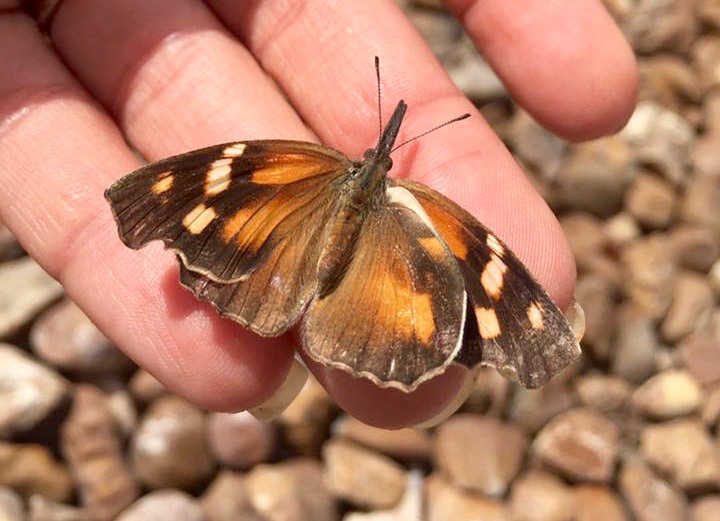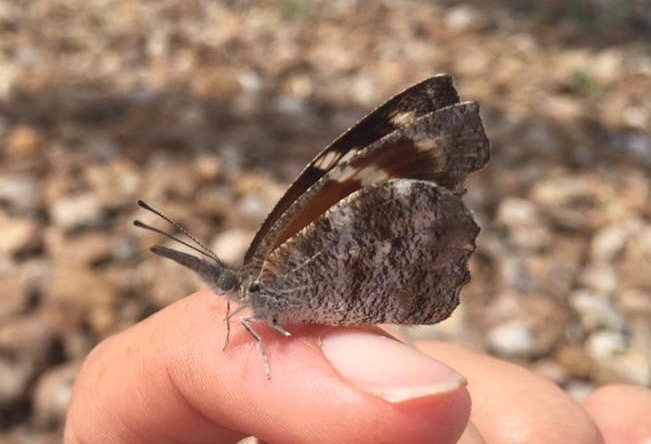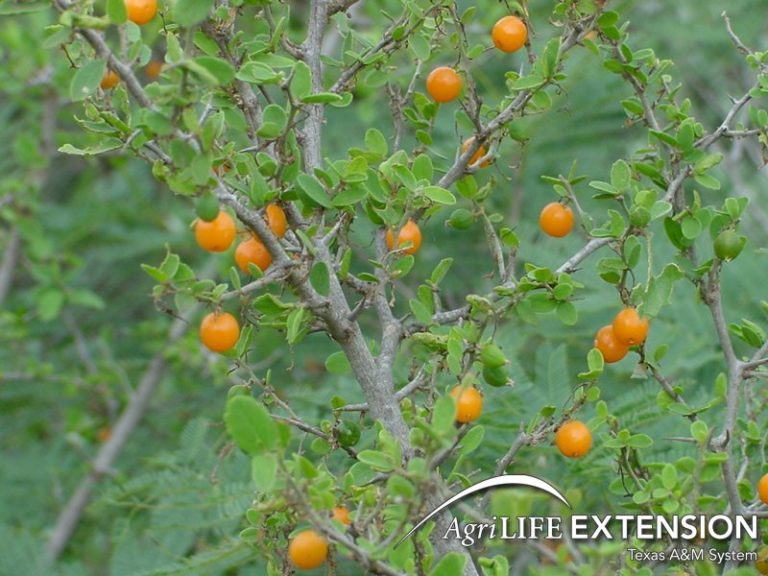While we’re waiting for Monarch butterflies to move through the Texas Funnel, another orange-and-black butterfly has made its presence known here en masse.

Snout butterflies are back in town. Photo by Drake White, the Nectar Bar
The American Snout butterfly, Libytheana carinenta, is currently moving around the IH-35 pollinator corridor, clogging windshields and car grills along the way.
The long-nosed butterfly with mottled black, orange and white coloration, migrates randomly around Central and South Texas following late summer rains, said Texas Entomologist Mike Quinn.
“It’s not a migration in the usual terms,” Quinn said. “They’re ’emigrating’ out of where they overpopulated and exhausted the food source, looking for new mates.”

Drake White of the Nectar Bar holds an American Snout-nosed Butterfly in San Antonio this week. Photo by Drake White
That food source is the hackberry tree, often considered a nuisance tree by landscapers and gardeners, but which is actually a fantastic wildlife plant. Its leaves provide food for snout caterpillars and its berries offer important winter sustenance for birds. Big snout invasions can completely defoliate a hackberry tree, but the tree will recover.

Hackberry, often considered a trash tree, provides food for snout caterpillars and other wildlife. Photo courtesy of Texas Agrilife.
The 2016 weather cycle set the stage for this year’s snout invasion, the likes of which we haven’t seen since 2012. The snout deluge should last about another two weeks.
A dry July followed by a wet August reduced the predators and favored the snouts, who can postpone reproductive activities until moisture returns. Late summer rains following dry spells also cause hackberry trees to sprout tender new growth – perfect fuel for baby snout caterpillars which are leaf green, and about an inch long when mature.
“Late summer rains are a hallmark of the snout explosion followed by mass movements in multiple directions,” Quinn said.
According to most recent reports, the snouts seem concentrated in the Edwards Plateau area.
Richard Kostecke, associate director of conservation at The Nature Conservancy of Texas in Austin, reported counting 376 snouts during a 30-minute run yesterday. Driving home from the Hill Country on Monday, I witnessed thousands of snouts smacking windshields on IH-10 around the Medina River near Comfort.
“I have tons of them at my house right now, but I also have a hackberry tree in my yard,” said Drake White, who lives on the northeast side and operates the Nectar Bar, a Facebook page devoted to helping people learn how to responsibly raise butterflies.
Social media was also aflutter with snout sightings.
“Those are snout nose (sic) butterflies & they are getting on my nerves! I’m not washing my car until I kill the last one!” tweeted Addie @addiesabatino, yesterday.
“Snout-nosed butterflies: I hope you ALL get to where you are going soon . . . I’ll help you pack AND buy your gas! ?,” Teresa Jackson Doty posted on FAcebook.
The mottled grey insects disguise themselves as dead leaves when their wings are closed. With wings open, they flaunt their orange, black and white accents and are sometimes confused with Monarchs or Painted Lady butterflies.
Snouts, so called because of their tubular, elephant trunk-like “noses,” lay eggs on the leaves of hackberry trees, the drought-tolerant native considered a trash shrub by some. The adult butterflies nectar on various flowering plants and live about two weeks.
In the annals of American Snout butterfly migrations, 1921 ranks as a most remarkable year. After a world record downpour in Central Texas on September 9-10, 1921, when 36.4 inches of rain fell in an 18-hour period, a Snout butterfly breakout resulted a few weeks later.
“An estimated 25 million per minute southeasterly-bound snout butterflies passed over a 250 mile front from San Marcos to the Rio Grande River,” according to Mike Quinn’s Texas Entomology, a trusted and entertaining source for Texas insect news and info. Scientists noted at the time that the butterflies’ flight “lasted 18 days and may have involved more that 6 billion butterflies.”
Related posts
- Urban Butterfly Garden Brings Monarchs and Swallowtails to your Front Yard
- Should You Bring in a Late Season Caterpillar into Your Home?
- How to Tell Queens from Monarchs
- How to Raise Monarch Butterflies at Home (First of Two Parts)
Like what you’re reading? Don’t miss a single post from the Texas Butterfly Ranch. Sign up for email delivery, like us on Facebook, or follow us on Twitter, @monikam.

I had an encounter with a snout just a few days ago that brought to mind a question rattling around in my brain ever since I was a kid. I remember watching comedian Orson Bean on the Tonight Show and wondering about the validity of what he described as an interspecial moment with a butterfly, in which he felt some connection. When mine came flitting along a few days ago, it landed on the handlebar of my tiller and then walked onto my outstretched finger. I brought it over to my wife, then it flew off and returned to land on the tiller again and rode along as I pushed the machine back to the shed. There’s probably an explanation, like something the snout liked on the handlebar, but at the very least I wonder sometimes about the fearlessness that butterflies seem to exhibit toward us.
Nice article. I have seen about 10 high in the post oaks in my south Denton County yard over the last few days. I have witnessed their huge eruptions in RGV multiple times.
We have Snouts here in Round Rock Texas, but we have also recently had Monarchs dropping by our Milk Weed and laying eggs. We currently have about 4 cats that I know of. We have plants in pots and in the ground. Looking forward to a Bumper crop of Monarchs we can release to head South for the winter.
Thanks for this, Monika. It kills me to hit anything with my car, but I am glad to know that we were in the flight-path of the snout. Clears up a mystery. Also, thanks for noting the hackberry’s role in wildlife protection.
Joel Sinor: One year we decided to attend the Bonsai Club meeting in San Antonio. We live at Canyon Lake. We had two Bonsai plants that we wanted to take in and ask the experts a few questions about them. I loaded the plants in the back seat of the car. We went to the meeting and I went out in the dark and retrieved the plants. Inside while asking people about the plants care etc one fellow noticed the two brown snout butterflies on the plant that we had seen after bringing the lighted room. We didn’t see them on the plants at home as it was late when we left. The fellow flicked one of the butterflies off the plant before we could stop him. It went flying around the room. I held the Bonsai plant up in the air and it landed back on it. I quickly placed the plants in the car and gave them a ride back to our porch at Canyon Lake. I hope they enjoyed the adventure!
the photo of the tree labeled hackberry doesn’t look
like the hackberry trees in my yard. is this photo correctly identified?
It doesn’t look like any hackberry in my yard either, and I hv tons…along my fences in the pasture of both our properties. One near the Colorado River near Columbus, Tx. And we also hv hackberries all over our second property along the Brazos River in Austin County near Belleville, Tx.
I noticed the same thing, so I looked it up. The photo is of a “Desert Hackberry”” Celtis ehrenbergiana” as opposed to the Southern Hackberry or Sugarberry “Celtis laevigata” variety we have here in the Hill Country. The desert variety seems to have smaller leaves and much larger fruit. I think butterflies all like both types.
Nice article, but how about posting an actual picture of a hackberry to illustrate hackberries. What’s pictured is not a hackberry.
Actually, it is. There are several species. http://www.wildflower.org/plants/result.php?id_plant=CEEH
My mistake. I know we have quite a few species here, but I was unaware of this one. Glancing at the picture I thought it was Ilex vomitoria.
There are two common types of “Hackberry” in South Texas. The Spiny Hackberry (Celtis ehrenbergiana) is a large bush typically growing amongst the native scrub brush. The berries are edible and make a fine jam. And the birds love the spiny cover and the berries as well. Green Jays love this plant. However, I think the variety this article includes is the Common Hackberry (Celtis occidentalis) because the article refers to Hackberry “Tree” (not bush or shrub). The Hackberry Tree is often the fast growing tree seen at the end of hedge rows or along fence lines and sometimes in yards and gardens. The wood (trunks & stems) is very brittle prone to wind breakage. And most all flying and climbing wildlife take refuge in this heavy-foliated tree from time to time (think birds, squirrels, rats, butteflies, insects, etc.)
Thanks, Stan Crockett for claryfing the issue re: the hack berries. I believe the spiny hackberry was known to us as ( granjeno, a spanish word ) where I was raised in the RGV.The berries were delicious.. Great article, bow.
Right now I am witnessing an incredible snout-nosed butterfly migration/emigration in the immediate vicinity of IH37 South & SE Military Drive. It has been going on since at least 1:30 pm today. The skies are filled with them. I estimate about 100 to 1000 are passing by per second (360.000 to 3.6 million per hour!!!). The world is changing with “climate change”. Some species will benefit while others may become extinct.
I’ve been meaning to follow-up for several days now about this huge migration. To my surprise they are still here. I love the article and butterflies. I grew up in San Diego where I would play with butterflies in my backyard. We had fuzzy black caterpillars and green caterpillars. I had no idea how special that time was. If anyone loves the butterfly, may I suggest the movie “Flight of the Monarch” .
Be good to one another
I have seen a snout in my yard for the last 2 days. It is a rare and welcomed sight for me here in Hemingway, SC, in Georgetown County (a coastal county). I have never seen a hackberry tree and don’t know if hackberries grow in this area at all. I would love to see the snout migration in Texas.
It looks like a blizzard here in Brackettville! There are thousands of these guys.
When driving on Hwy 90 from Uvalde going east My front end was caked with
dead snot nose butterflies. My front yard has 100’s I’d them flying around my pecan tree. They may like the sap from the tree… who knows.
The snout opens and closes like a bird beak – so I am assuming he/she eats like a bird
The snout nose butterflies are flying and landing on my lime tree. There are hundreds of them and there is a white residue on the leaves. I cannot figure out if they are leaving this residue or eating some of it. Please advise.
It’s happening again, McAllen/Edcouch area, unending wave, South bound.
11/18/23